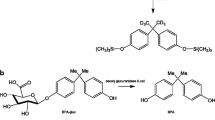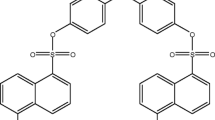Abstract
Steroid hormone levels in human urine are convenient and sensitive indicators for the impact of phthalates and/or bisphenol A (BPA) exposure on the human steroid hormone endocrine system. In this study, a rapid and sensitive method for determination of 14 phthalate metabolites, BPA, and ten endogenous steroid hormones in urine was developed and validated on the basis of ultra-performance liquid chromatography coupled with electrospray ionization triple quadrupole mass spectrometry. The optimized mixed-mode solid phase-extraction separated the weakly acidic or neutral BPA and steroid hormones from acidic phthalate metabolites in urine: the former were determined in positive ion mode with a methanol/water mobile phase containing 10 mM ammonium formate; the latter were determined in negative ion mode with a acetonitrile/water mobile phase containing 0.1 % acetic acid, which significantly alleviated matrix effects for the analysis of BPA and steroid hormones. Dansylation of estrogens and BPA realized simultaneous and sensitive analysis of the endogenous steroid hormones and BPA in a single chromatographic run. The limits of detection were less than 0.84 ng/mL for phthalate metabolites and less than 0.22 ng/mL for endogenous steroid hormones and BPA. This proposed method had satisfactory precision and accuracy, and was successfully applied to the analyses of human urine samples. This method could be valuable when investigating the associations among endocrine-disrupting chemicals, endogenous steroid hormones, and relevant adverse outcomes in epidemiological studies.

Analytical flowchart of phthalate metabolites, bisphenol A, and endogenous steroid hormones in human urine
Similar content being viewed by others
References
Guo Y, Alomirah H, Cho HS, Minh TB, Mohd MA, Nakata H, Kannan K (2011) Occurrence of phthalate metabolites in human urine from several Asian countries. Environ Sci Technol 45(7):3138–3144
Calafat AM, Ye X, Wong L, Reidy JA, Needham LL (2008) Exposure of the US population to bisphenol A and 4-tertiary-octylphenol: 2003–2004. Environ Health Perspect 116(1):39–44
Rubin BS (2011) Bisphenol A: an endocrine disruptor with widespread exposure and multiple effects. J Steroid Biochem 127(1-2SI):27–34
Swan SH (2008) Environmental phthalate exposure in relation to reproductive outcomes and other health endpoints in humans. Environ Res 108(2):177–184
Diamanti-Kandarakis E, Bourguignon J, Giudice LC, Hauser R, Prins GS, Soto AM, Zoeller RT, Gore AC (2009) Endocrine-disrupting chemicals: an Endocrine Society scientific statement. Endocr Rev 30(4):293–342
Casals-Casas C, Desvergne B (2011) Endocrine disruptors: from endocrine to metabolic disruption. Annu Rev Physiol 73:135–162
Meeker JD, Calafat AM, Hauser R (2009) Urinary metabolites of di(2-ethylhexyl) phthalate are associated with decreased steroid hormone levels in adult men. J Androl 30(3):287–297
Duty SM, Calafat AM, Silva MJ, Ryan L, Hauser R (2005) Phthalate exposure and reproductive hormones in adult men. Hum Reprod 20(3):604–610
Fedejko B, Mazerska Z (2011) UDP-glucuronyltransferases in detoxification and activation metabolism of endogenous compounds and xenobiotics. Postepy Biochem 57(1):49–62
Ritter JK (2000) Roles of glucuronidation and UDP-glucuronosyltransferases in xenobiotic bioactivation reactions. Chem Biol Interact 129(1–2):171–193
Blount BC, Milgram KE, Silva MJ, Malek NA, Reidy JA, Needham LL, Brock JW (2000) Quantitative detection of eight phthalate metabolites in human urine using HPLC-APCI-MS/MS. Anal Chem 72(17):4127–4134
Wang HX, Zhou Y, Jiang QW (2013) Enhanced screening efficiency for endocrine-disrupting chemicals in milk and powdered milk using UPLC/QTOF-MS by the introduction of dansyl chloride derivatisation. Food Addit Contam Part A Chem Anal Control Expo Risk Assess 30(1):166–180
Gonzalez-Marino I, Quintana JB, Rodriguez I, Gonzalez-Diez M, Cela R (2012) Screening and selective quantification of illicit drugs in wastewater by mixed-mode solid-phase extraction and quadrupole-time-of-flight liquid chromatography-mass spectrometry. Anal Chem 84(3):1708–1717
Ho EN, Leung DK, Wan TS, Yu NH (2006) Comprehensive screening of anabolic steroids, corticosteroids, and acidic drugs in horse urine by solid-phase extraction and liquid chromatography-mass spectrometry. J Chromatogr A 1120(1–2):38–53
Xu X, Veenstra TD, Fox SD, Roman JM, Issaq HJ, Falk R, Saavedra JE, Keefer LK, Ziegler RG (2005) Measuring fifteen endogenous estrogens simultaneously in human urine by high-performance liquid chromatography-mass spectrometry. Anal Chem 77:6646–6654
Commission Decision (2002/657/EC) of 12 August 2002 implementing Council Directive 96/23/EC concerning the performance of analytical methods and the interpretation of results. Off J Eur Communities L221:8–36
Hoffmann P, Hartmann MF, Remer T, Zimmer KP, Wudy SA (2010) Profiling oestrogens and testosterone in human urine by stable isotope dilution/benchtop gas chromatography–mass spectrometry. Steroids 75(13–14):1067–1074
Palermo M, Gomez-Sanchez C, Roitman E, Shackleton CH (1996) Quantitation of cortisol and related 3-oxo-4-ene steroids in urine using gas chromatography/mass spectrometry with stable isotope-labeled internal standards. Steroids 61(10):583–589
Becker K, Goen T, Seiwert M, Conrad A, Pick-Fuss H, Muller J, Wittassek M, Schulz C, Kolossa-Gehring M (2009) Geres IV: phthalate metabolites and bisphenol A in urine of German children. Int J Hyg Environ Health 212(6):685–692
Casas L, Fernandez MF, Llop S, Guxens M, Ballester F, Olea N, Irurzun MB, Rodriguez LS, Riano I, Tardon A, Vrijheid M, Calafat AM, Sunyer J (2011) Urinary concentrations of phthalates and phenols in a population of Spanish pregnant women and children. Environ Int 37(5):858–866
Silva MJ, Barr DB, Reidy JA, Malek NA, Hodge CC, Caudill SP, Brock JW, Needham LL, Calafat AM (2004) Urinary levels of seven phthalate metabolites in the US population from the National Health and Nutrition Examination Survey (NHANES) 1999–2000. Environ Health Perspect 112(3):331–338
Bushnik T, Haines D, Levallois P, Levesque J, Van Oostdam J, Viau C (2010) Lead and bisphenol a concentrations in the Canadian population. Health Rep 21(3):7–18
Lakind JS, Naiman DQ (2011) Daily intake of bisphenol A and potential sources of exposure: 2005–2006 national health and nutrition examination survey. J Expo Anal Environ Epidemiol 21(3):272–279
Acknowledgments
This project was supported by the Key Laboratory of Public Health Safety of the Ministry of Education, School of Public Health, Fudan University, China. It was also funded by the Young Foundation of Fudan University, China (EYF 201023) and the Project 985 Innovation Platform for Superiority Subject, of the Ministry of Education, China.
Author information
Authors and Affiliations
Corresponding author
Electronic supplementary material
Below is the link to the electronic supplementary material.
ESM 1
(PDF 955 KB)
Rights and permissions
About this article
Cite this article
Wang, Hx., Wang, B., Zhou, Y. et al. Rapid and sensitive analysis of phthalate metabolites, bisphenol A, and endogenous steroid hormones in human urine by mixed-mode solid-phase extraction, dansylation, and ultra-performance liquid chromatography coupled with triple quadrupole mass spectrometry. Anal Bioanal Chem 405, 4313–4319 (2013). https://doi.org/10.1007/s00216-013-6779-3
Received:
Revised:
Accepted:
Published:
Issue Date:
DOI: https://doi.org/10.1007/s00216-013-6779-3




